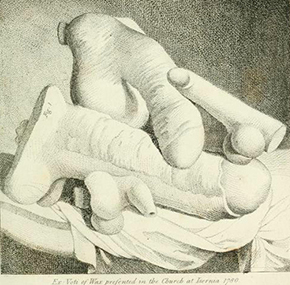The Proposition
If the Rescue paintings and drawings are ex-votos commemorating Marie-Thérèse’s salvation from drowning, as Richardson and Widmaeir Picasso suggest, then it is very likely that the Une Anatomie drawings, which appeared towards the end of her convalescence, may also represent ex-votos, albeit clothed in the languages of surrealism and African sculpture. The principal requirement for an ex-voto is that it must visualise the trauma that the person is saved from and the anatomy drawings do that by depicting fleshless skeletal forms that mirror the emaciated condition caused by the spirochete bacteria. Coming from a catholic family Picasso would have been very familiar with ex-voto traditions involving the creation and grateful donation of images that depicted the event from which the person had been miraculously saved by divine intervention. In volume 3 of his magnum opus on Picasso, Richardson made a direct link between a sexual-wellbeing ex-voto and Picasso’s painting Figures on a Seashore, 1931 (Figs. 22-23). He believed that Picasso was either familiar with this engraving or that he encountered similar ex-votos during his visit to Naples in 1917 and that, “Those ex-votos would inspire Picasso to make some votive pieces of his own ....” (Richardson 2009: 437-8; 2021: 8).
Making a link between the Une Anatomie drawings and ex-votos is less fanciful, when we consider that after encountering African masks during his 1907 visit to the Trocadéro Ethnographic Museum in Paris, he totally embraced the belief that art and life had to be interdependent and both ostensibly driven by feelings of anxiety. For him there was no real art without anxiety, “It’s not what the artist does that counts, but what he is. Cézanne would never have interested me a bit if he had lived and thought like Jacques Emile Blanche, even if the apple he painted had been ten times as beautiful. What forces our interest is Cezanne’s anxiety — that’s Cezanne’s lesson; the torments of van Gogh — that is the actual drama of the man. The rest is a sham.” (Picasso: Fifty years of his art, Museum of Modern Art, 1946: 274)
 23
23Fig.22 Picasso. Figures on a Seashore, painting, 1931
Fig.23 Ex-Votos in William Hamilton, Richard Payne Knight, and the phalli of Isernia, 1786